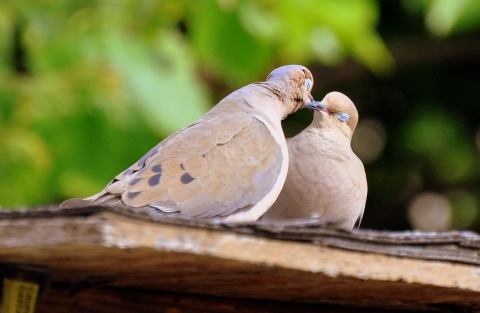Settling Down
Spring is the time when mourning doves will rejoin their partners and choose a nesting site. Like many humans, mourning doves are monogamous and often mate for life. It is not uncommon to see them display their affection for each other, whether it be preening, cuddling or a sweet gentle coo when greeting one another.
When it’s time to build their nest, the male will find a site that the female approves of, for the pair to begin constructing their nest out of twigs and grass. Typically, it takes a pair three to four days to complete their nests, however some mourning doves will quickly throw a nest together in a few hours.
Parenting Life
The female dove will typically lay two white eggs within a few days of completed nest construction. Both parents will incubate the eggs for 14 days and, when hatched, their babies will stay at home for two weeks before they are ready to fly.
During these two weeks, both mom and dad work together to feed their new babies something called “pigeon milk” for the first few days of their lives. This milk is rich in protein and fat, resembles cottage cheese and is secreted by the adults’ crop lining and regurgitated to the nestlings. By the fourth day of life, babies’ diets transition to seeds, and after 11 to 15 days the youngsters are nearly mature. Although they are ready to be on their own, younglings will stay close to their parents and continue to be fed by them for another week or two. Parents may have up to five or six broods of baby mourning doves in one season.
Mourning doves are generalists and can be spotted throughout the refuge, with most recent sightings at the Bass Ponds and Old Cedar Avenue trailheads. Venture out on a nice day, and you may be able to see and hear a pair of these love birds!





